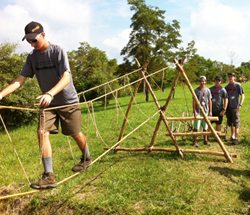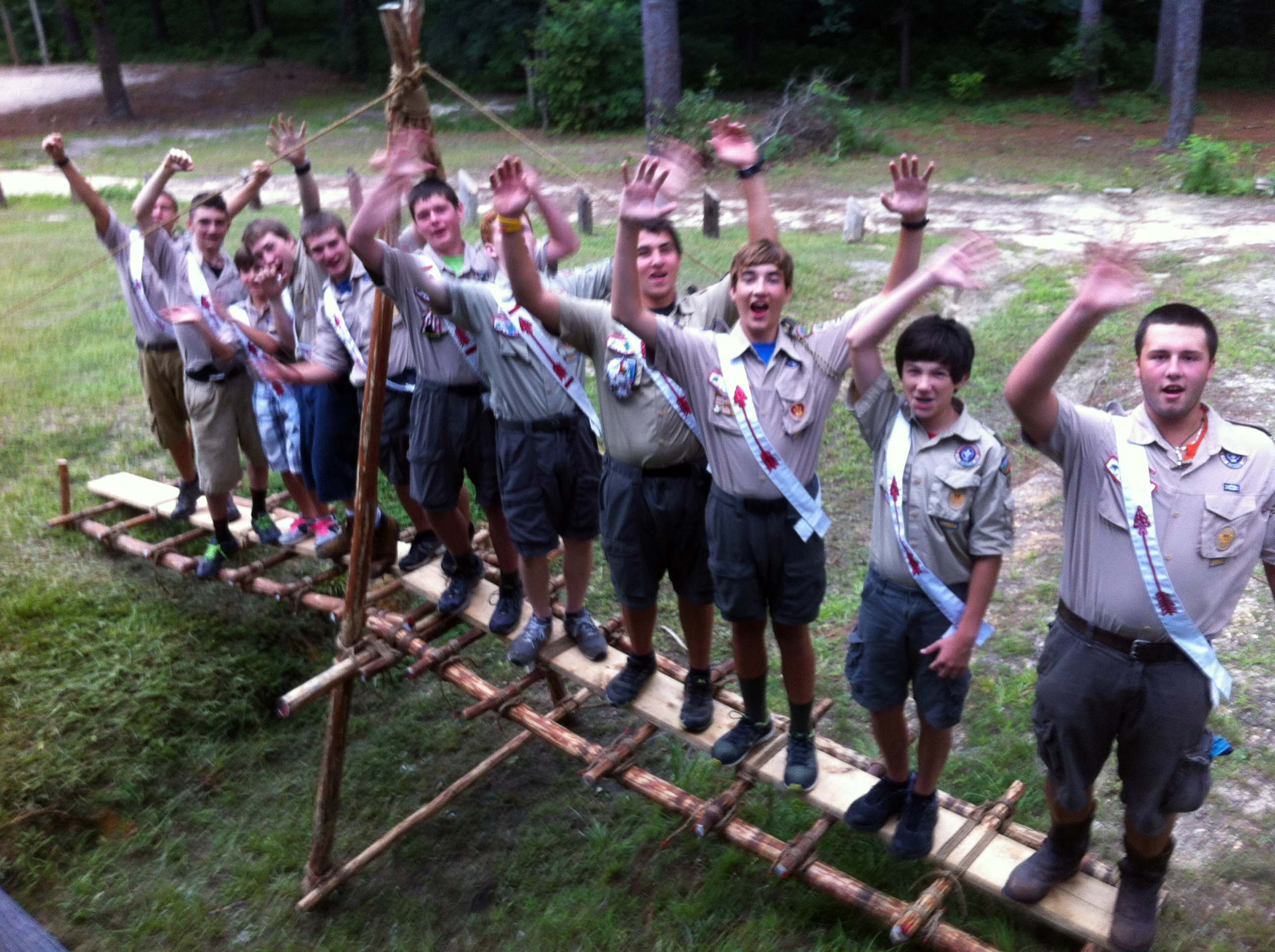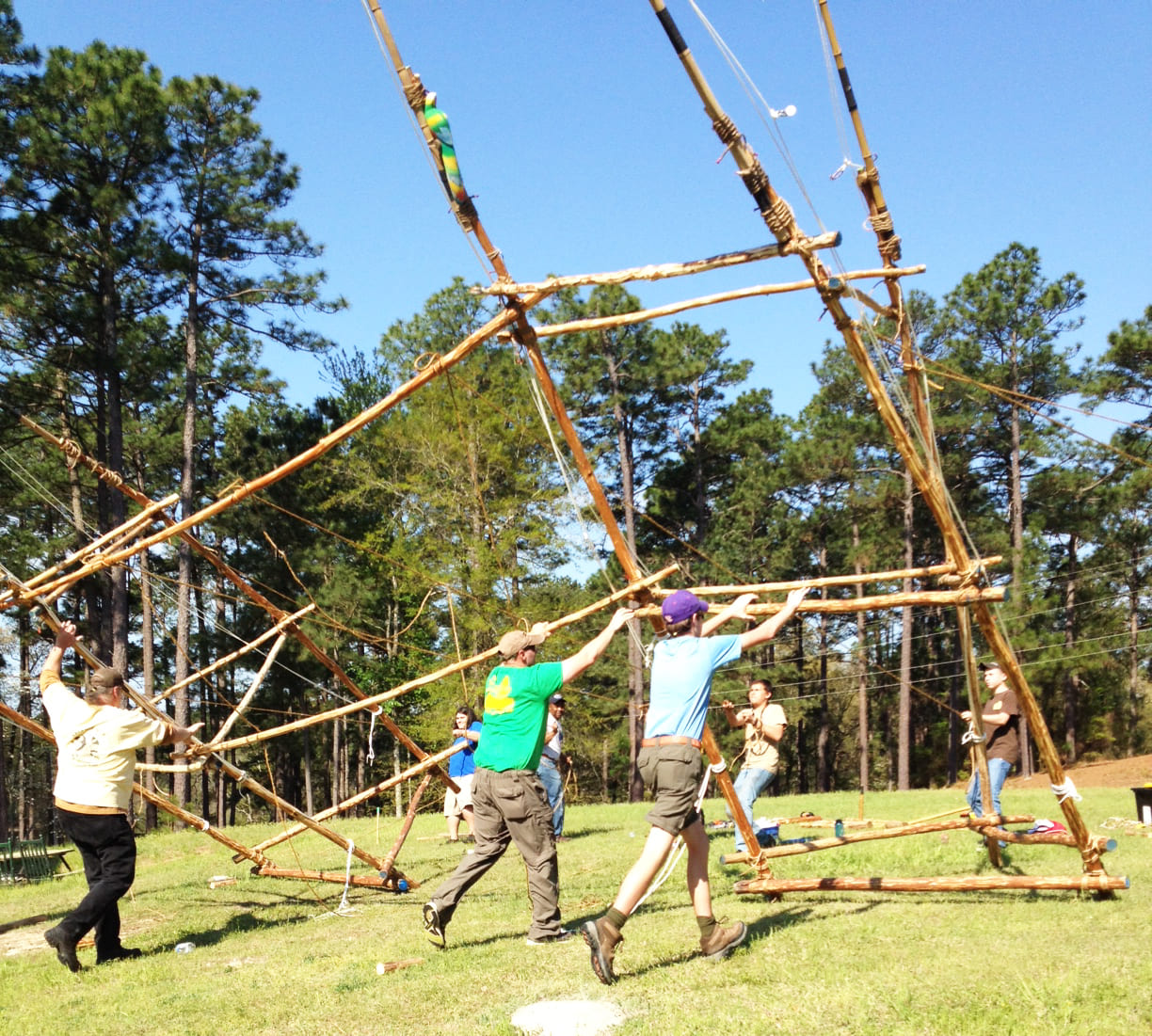Related Advancement
- First Class requirements 3a, 3b, 3c, 3d
- Pioneering Merit Badge
What is Pioneering? – Pioneering is the knowledge and skill of using simple materials to build structures that are used in a wide range of Scouting activities. These skills are sometimes referred to as “backwoods engineering.”

Down through the ages, people have used ropes, spars, and simple hardware to build bridges, towers, and even their own shelters. In the early development of our country, pioneering methods were used in mining and transportation, to clear the wilderness, and to build roads and bridges. So it is understandable that the term “backwoods engineering” was applied.

The same skills can be used by Scouts to build pioneering projects ranging in complexity from a simple camp gadget to a sturdy bridge.
Whatever the project, the same applied principles of physics, geometry, and math are used to build pioneering structures. But, keep in mind that all the information in this program feature is eventually used for a practical, hands-on application—that is, to build something.
Pioneering is a good foundation for many Scouting activities. You must learn, and then put into practice, such disciplines as planning ahead and teamwork. You can also put to use the basic skills learned in rank advancement, such as knot tying and lashing. But most of all, pioneering provides a practical way to experience the joy of accomplishment when you’ve built something that is useful for yourself or others.
 Ideas for Main Event Camp Gadgets
Ideas for Main Event Camp Gadgets
Ideas for Main Event Pioneering Projects
 View: Ropes and Spars
View: Ropes and Spars
Refer to: “Pioneering Stumbling Blocks for those Who haven’t gotten Started Yet”
Relevant Pioneering Skill Videos with Further Information
- Square Lashing
- Round Lashing
- Tripod Lashing
- Shear Lashing
- Roundturn with Two Half Hitches
- Diagonal Lashing
- Butterfly Knot
- Rope Tackle (Truckers Hitch)
- Clove Hitch / Half Hitches
- “Anchoring Pioneering Projects”

In all Scouting activities, safety must come first. In and through the challenges, fun, and rewards that go hand in hand with pioneering, there can be no substitute for prudent behavior and common sense. As you begin your pioneering activities, safety must be your first consideration. The following safety points are some that you and your group should keep in mind:
Pioneering Safety Points
1) Before and after each use, check all equipment, ropes, poles, tools, and hardware to ensure they are in good working condition.
2) All equipment should be treated with respect and used appropriately for its intended purpose.
3) Appoint a safety officer who, along with the rest of the group, should constantly check the work site to keep it clean of debris. Equipment should be kept in an organized fashion before, during, and after its use.
4) During the construction of a project, only one person should give instructions and signals.
5) There should always be plenty of room between the person carrying spars and people around them.
6) Do not work during rainy or wet conditions. Rope and spars become slippery, as does your footing. Knots can slip when wet and become unsafe.
7) Wear clothing to fit the season and wear gloves when necessary to protect your hands.Work smart and do not lift more than you can handle.
8) Spars resting on the ground are not for standing upon. They can unexpectedly roll causing injuries.
9) When lifting a spar to facilitate the frapping of a Tripod or Shear Lashing, care should always be taken to ensure the person working the rope doesn’t injure their fingers.

10) Take regular breaks to discuss the work in progress and ensure that everyone understands what is required of them.
11) Use extra care when using heavy mallets to pound in pioneering stakes.
12) For added safety, heel in the legs of a structure from 4 to 6 inches.
13) If the design calls for a certain size and type of rope or spar, do not substitute something of lesser strength.
14) Before allowing general use, run a complete test to see everything is working correctly.
15) Keep checking all anchors on the pioneering project as strain is applied during use.
16) The number of people using a platform should be strictly limited to the maximum number established beforehand and announced by the safety officer.
17) There should only be one person on a monkey bridge at a time.
18) Jumping or playing around while on a structure unacceptable. Like with this Single A-Frame Bridge they built at the national jamboree, Scouts should only climb on board their project after all lashings are tight, and the structure has been completely inspected.
19) While crossing a monkey bridge, people shouldn’t bounce or purposely swing or sway on the ropes, nor should anyone race to see how quickly they can get across.
20) Those waiting their turn to cross a monkey bridge should stay off the ropes between the anchors and the bridge framework.
21) Everyone should stay completely off a monkey bridge whenever the foot and hand ropes are being tightened, or the spanner ropes are being adjusted.
22) When the day’s work is complete, untie all knots, coil all ropes, check all hardware, and store everything in its proper place.

SaveSave
SaveSave
SaveSave
SaveSave
